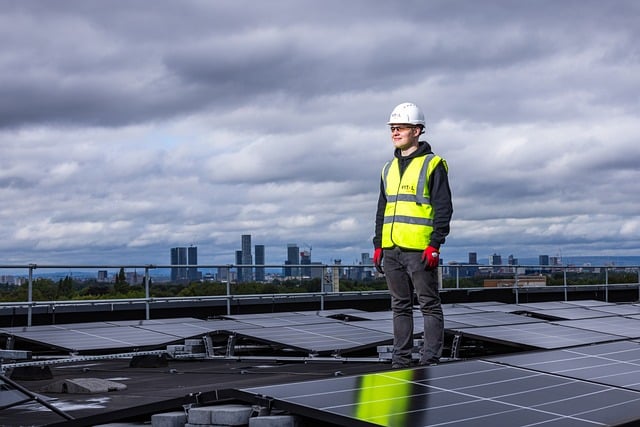“Unlocking Solar Efficiency: Identify Common Monitoring Issues and Implement Effective Solutions.”
Solar performance monitoring is essential for ensuring the efficiency and effectiveness of solar energy systems. However, several common issues can arise that hinder optimal performance. These include inaccurate data collection due to faulty sensors, communication failures between monitoring devices, and inadequate system calibration. Environmental factors, such as shading from nearby structures or debris accumulation on panels, can also significantly impact energy output. To address these challenges, regular maintenance and inspections are crucial, along with the implementation of advanced monitoring technologies that provide real-time data and alerts. Additionally, ensuring proper installation and positioning of solar panels can mitigate shading issues, while routine cleaning can enhance energy capture. By proactively identifying and resolving these issues, solar system owners can maximize their investment and contribute to sustainable energy production.
Inaccurate Data Reporting
Inaccurate data reporting is a prevalent issue in solar performance monitoring that can significantly undermine the effectiveness of solar energy systems. When solar panels are installed, they are equipped with monitoring systems designed to track their performance, energy production, and overall efficiency. However, discrepancies in data reporting can arise from various sources, leading to misinterpretations of a system’s performance. Understanding these inaccuracies is crucial for optimizing solar energy production and ensuring that systems operate at their intended capacity.
One common cause of inaccurate data reporting is the calibration of monitoring equipment. If the sensors and meters used to collect data are not properly calibrated, the readings can be skewed, resulting in misleading information about energy output. For instance, a solar inverter that is not calibrated correctly may report higher or lower energy production than what is actually generated. To address this issue, regular maintenance and calibration checks should be performed on all monitoring equipment. This proactive approach ensures that the data collected is reliable and reflects the true performance of the solar system.
Another factor contributing to inaccurate data reporting is the presence of shading on solar panels. Shading can occur due to nearby trees, buildings, or even dirt and debris accumulating on the panels. When shading occurs, it can significantly reduce the amount of sunlight that reaches the solar cells, leading to a drop in energy production. If the monitoring system does not account for these shading effects, it may report lower energy output than expected. To mitigate this issue, it is essential to conduct regular inspections of the solar array to identify and address any potential shading problems. Additionally, implementing smart monitoring solutions that can detect shading patterns can provide more accurate performance data.
Moreover, software glitches and communication errors can also lead to inaccurate data reporting. Solar monitoring systems often rely on complex software to analyze and report performance metrics. If there are bugs in the software or if the system experiences connectivity issues, the data reported may be incomplete or erroneous. To combat this, it is advisable to keep the monitoring software updated and to conduct routine checks on the system’s connectivity. By ensuring that the software is functioning correctly and that data is being transmitted without interruption, operators can enhance the accuracy of the performance reports.
Furthermore, human error can play a significant role in data inaccuracies. Operators may misinterpret the data or fail to input information correctly, leading to flawed conclusions about the system’s performance. To minimize the risk of human error, it is beneficial to provide comprehensive training for personnel involved in monitoring and analyzing solar performance data. By equipping staff with the necessary knowledge and skills, organizations can improve the accuracy of their reporting and make more informed decisions regarding system maintenance and optimization.
In conclusion, addressing the issue of inaccurate data reporting in solar performance monitoring is essential for maximizing the efficiency and effectiveness of solar energy systems. By focusing on proper calibration of equipment, regular inspections for shading, maintaining software integrity, and minimizing human error through training, operators can significantly enhance the reliability of their performance data. Ultimately, accurate data reporting not only helps in optimizing energy production but also contributes to the overall success and sustainability of solar energy initiatives.
Communication Failures Between Devices

In the realm of solar performance monitoring, communication failures between devices can significantly hinder the efficiency and reliability of solar energy systems. These failures often manifest as data discrepancies, delayed reporting, or complete loss of communication, which can lead to misinformed decisions regarding system maintenance and performance optimization. Understanding the root causes of these communication issues is essential for effective troubleshooting and resolution.
One common issue arises from the use of incompatible communication protocols among different devices. Solar monitoring systems typically consist of various components, including inverters, sensors, and data loggers, each of which may utilize different communication standards. When these devices cannot effectively communicate, it can result in incomplete or inaccurate data being transmitted to the monitoring platform. To address this, it is crucial to ensure that all components are compatible and adhere to the same communication protocols. This may involve upgrading firmware or replacing devices that do not support the necessary standards.
Another factor contributing to communication failures is poor network connectivity. Solar monitoring systems often rely on wireless communication, which can be susceptible to interference from physical obstructions, such as buildings or trees, as well as electronic interference from other devices. To mitigate these issues, it is advisable to conduct a thorough site assessment to identify potential sources of interference and optimize the placement of communication devices. Additionally, utilizing a robust network infrastructure, such as a dedicated Wi-Fi network or a cellular connection, can enhance the reliability of data transmission.
Moreover, environmental factors can also play a significant role in communication failures. Extreme weather conditions, such as heavy rain, snow, or high winds, can disrupt wireless signals and lead to temporary communication lapses. To combat this, it is essential to invest in weather-resistant communication equipment and ensure that all devices are securely mounted and protected from the elements. Regular maintenance checks can also help identify any wear and tear that may compromise the integrity of the communication system.
In some cases, software-related issues can lead to communication failures. Outdated software or firmware can result in bugs that disrupt data transmission or processing. Therefore, it is vital to keep all software up to date and to implement a regular maintenance schedule that includes software updates. Additionally, monitoring platforms should be equipped with diagnostic tools that can help identify and resolve software-related issues promptly.
Furthermore, human error can contribute to communication failures in solar performance monitoring systems. Incorrect configurations, such as misconfigured IP addresses or network settings, can prevent devices from communicating effectively. To minimize the risk of human error, it is essential to provide comprehensive training for personnel involved in the installation and maintenance of solar monitoring systems. Clear documentation and standardized procedures can also help ensure that all configurations are performed correctly.
In conclusion, communication failures between devices in solar performance monitoring can stem from a variety of factors, including incompatible protocols, poor network connectivity, environmental challenges, software issues, and human error. By addressing these common issues through careful planning, regular maintenance, and ongoing training, solar energy systems can achieve optimal performance and reliability. Ultimately, ensuring effective communication among devices is crucial for maximizing the benefits of solar energy and supporting the transition to a more sustainable future.
Environmental Factors Affecting Performance
Solar performance monitoring is a critical aspect of ensuring that photovoltaic systems operate at their optimal efficiency. However, various environmental factors can significantly impact the performance of solar panels, leading to discrepancies between expected and actual energy output. Understanding these factors is essential for effective monitoring and maintenance, as it allows for timely interventions that can enhance system performance.
One of the most significant environmental factors affecting solar performance is shading. Trees, buildings, and even dirt accumulation can obstruct sunlight from reaching the solar panels, resulting in reduced energy production. To mitigate this issue, regular inspections should be conducted to identify potential sources of shading. If trees are found to be encroaching on the solar array, trimming or removal may be necessary. Additionally, cleaning the panels to remove dust and debris can help maximize sunlight exposure, thereby improving overall efficiency.
Another critical factor is temperature. While solar panels are designed to convert sunlight into electricity, they are also sensitive to temperature fluctuations. High temperatures can lead to a decrease in efficiency, as the semiconductor materials within the panels become less effective at converting sunlight into energy. To address this issue, it is essential to monitor the temperature of the solar panels regularly. If overheating is detected, consider implementing cooling solutions, such as increasing airflow around the panels or installing reflective materials to reduce heat absorption.
Moreover, the angle and orientation of solar panels play a vital role in their performance. Panels that are not optimally positioned may not capture the maximum amount of sunlight throughout the day. Therefore, it is crucial to assess the installation angle and orientation relative to the sun’s path. Adjustments may be necessary, especially in regions with varying seasonal sunlight. For fixed installations, ensuring that panels are tilted at the correct angle can significantly enhance energy capture.
Weather conditions also have a profound impact on solar performance. Cloud cover, rain, and snow can temporarily reduce the amount of sunlight reaching the panels. While these conditions are often beyond our control, understanding their effects can help in performance monitoring. For instance, during periods of prolonged cloudiness, energy production may drop significantly. By comparing historical weather data with energy output, operators can better understand the relationship between weather patterns and solar performance, allowing for more accurate forecasting and planning.
Additionally, pollution and environmental debris can accumulate on solar panels, obstructing sunlight and reducing efficiency. In urban areas, smog and particulate matter can create a film on the surface of the panels, necessitating regular cleaning. Implementing a routine maintenance schedule that includes cleaning can help ensure that panels remain free from obstructions, thereby optimizing performance.
Finally, seasonal changes can also affect solar performance. In winter, snow accumulation can block sunlight, while in summer, increased temperatures can lead to efficiency losses. Understanding these seasonal variations allows for better planning and maintenance strategies. For example, installing snow guards or heating elements can help mitigate snow accumulation, while ensuring proper ventilation can alleviate overheating during hotter months.
In conclusion, environmental factors such as shading, temperature, panel orientation, weather conditions, pollution, and seasonal changes all play a crucial role in solar performance. By actively monitoring these elements and implementing appropriate solutions, operators can enhance the efficiency and longevity of their solar systems, ultimately leading to improved energy production and cost savings.
Lack of Regular Maintenance and Inspections
Solar energy systems are increasingly recognized for their ability to provide clean, renewable energy, yet their performance can be significantly hindered by a lack of regular maintenance and inspections. This oversight can lead to a range of issues that not only diminish energy output but also shorten the lifespan of the solar installation. Therefore, understanding the importance of routine maintenance is crucial for maximizing the efficiency and longevity of solar systems.
One of the most common problems arising from inadequate maintenance is the accumulation of dirt, dust, and debris on solar panels. Over time, this buildup can obstruct sunlight from reaching the photovoltaic cells, resulting in reduced energy production. In regions with frequent dust storms or heavy pollen seasons, the impact can be particularly pronounced. To mitigate this issue, it is essential to establish a regular cleaning schedule. Depending on the local environment, this may involve cleaning the panels every few months or even more frequently in particularly dusty areas. Utilizing a soft brush or a gentle water spray can effectively remove debris without damaging the panels.
In addition to physical obstructions, the electrical components of a solar system can also suffer from neglect. Connections can become loose, and wiring can deteriorate over time, leading to inefficiencies or even system failures. Regular inspections by qualified technicians can identify these issues before they escalate. During these inspections, technicians can check for signs of wear and tear, ensure that all connections are secure, and replace any damaged components. This proactive approach not only enhances performance but also helps prevent costly repairs down the line.
Moreover, monitoring the performance of a solar system is vital for identifying potential issues early on. Many modern solar installations come equipped with monitoring software that tracks energy production and system health. However, without regular checks, users may overlook significant drops in performance that could indicate underlying problems. By setting up alerts for unusual performance metrics, system owners can take immediate action to address any issues. This could involve contacting a professional for further investigation or performing simple troubleshooting steps themselves.
Another critical aspect of maintenance is the inspection of the inverter, which is responsible for converting the direct current (DC) generated by the solar panels into alternating current (AC) for use in homes and businesses. Inverters can experience failures due to overheating, electrical surges, or age. Regular maintenance checks can help ensure that the inverter is functioning optimally. If an inverter is found to be underperforming, it may need recalibration or replacement, which can be addressed during routine inspections.
Furthermore, vegetation management is an often-overlooked aspect of solar maintenance. Trees and shrubs can grow over time, casting shadows on solar panels and reducing their efficiency. Regularly trimming back vegetation around the installation can help maintain optimal sunlight exposure. This not only enhances energy production but also reduces the risk of damage from falling branches during storms.
In conclusion, the lack of regular maintenance and inspections can lead to a host of issues that compromise the performance of solar energy systems. By implementing a routine maintenance schedule, conducting regular inspections, and utilizing monitoring technology, solar system owners can ensure their installations operate at peak efficiency. This proactive approach not only maximizes energy output but also extends the lifespan of the system, ultimately leading to a more sustainable and cost-effective energy solution.
Q&A
1. **Question:** What is a common issue with solar panel performance monitoring related to data accuracy?
**Answer:** Data inaccuracies can arise from faulty sensors or incorrect calibration. To fix this, regularly check and calibrate sensors, and replace any malfunctioning equipment.
2. **Question:** How can shading affect solar performance monitoring?
**Answer:** Shading from trees, buildings, or debris can significantly reduce energy output. To address this, regularly inspect the installation site for potential shading and trim or remove obstructions as needed.
3. **Question:** What issue can arise from inverter performance in solar systems?
**Answer:** Inverters can experience failures or inefficiencies, leading to reduced energy conversion. To resolve this, monitor inverter performance regularly and perform maintenance or replace inverters when necessary.
4. **Question:** How does weather impact solar performance monitoring?
**Answer:** Weather conditions like cloud cover or rain can affect energy production readings. To mitigate this, use historical weather data to analyze performance trends and adjust expectations accordingly.
Conclusion
Common issues in solar performance monitoring include inaccurate data collection, communication failures, sensor malfunctions, and inadequate data analysis. To address these problems, regular maintenance and calibration of monitoring equipment should be implemented, along with the use of reliable communication protocols. Employing advanced analytics and machine learning can enhance data interpretation, while ensuring that all components are compatible and functioning correctly can prevent sensor-related issues. Additionally, training personnel on monitoring systems can improve response times to any anomalies detected. By proactively addressing these issues, the overall efficiency and reliability of solar performance monitoring can be significantly improved.




